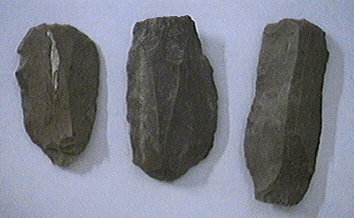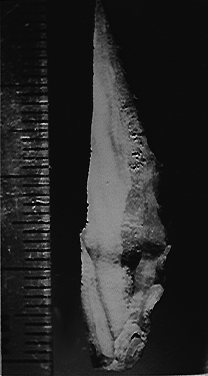


| 3 retouched blades | location unknown |  |
| 1 large retouched blade (Juan knife) | Hardway Downs, QLD |  |
| 1 large blade with gum hafting (Leilira blade) | location unknown |  |
There are 3 types of blades in the collection, all varying in different sizes the largest approximately 18cms (that being the Juan knife).
Within the vast range of Aboriginal stone implements, there is a vast amount of variety in blades and also in flakes. Often long sharp edged impplements are referred to as knives and many of these are hafted with gum or are bound onto the wooden implements. In the collection, one of the blades is known as the Juan knife, because the blade is asymmetrical with a ridge along one side. "It thus has a thick back which is usually trimmed along both edges from butt to point"(McCarthy, 1976: P35-36)
The other large blade with hafting gum residue is known as a Leilira blade which is a long pointed triangular blade. Due to the gum residue it is safe to suggest that the blade was hafted at some stage either as a knife or a pick. Both the Juan and the Leilira blades were important stone implements for use in ceremonies and rituals, such as - the "cutting up of animals, cutting cicatrice scars, circumcision and subincisions on men and introcisions on women" (McCarthy, 1976: p35). They were often used as spearheads and picks in different areas of Australia.
The 3 retouched blades were probably struck from carefully quarried and prepared cores and were most likely used for cutting or slicing food or materials such as fur, cloth or twines. These blades could have been used in almost any function that required an extremely strong, sharp edge.

Magnified asymmetric blade -
with rough patches on retouched blunt end and evidence of resin for hafting
(photo taken from the collection)
The article by D.A. Casey, I.M. Crawford, R.V.S. Wright entitled The Recognition, Description, Classification and Nomenclature of Australian Stone Implements is a useful source for information about Leilira blades.






